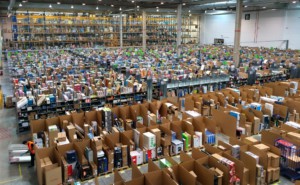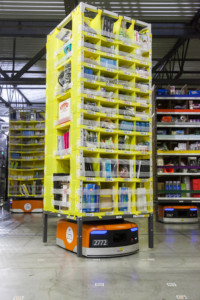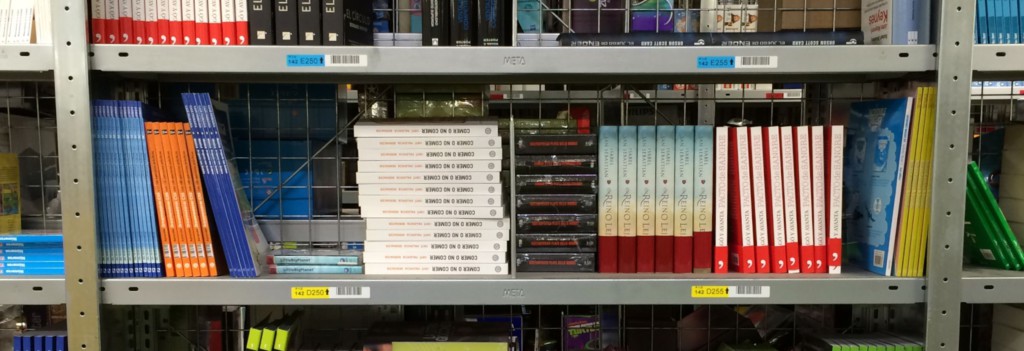 This is the second post in my series on the inner workings of Amazon Fulfillment Centers. In this post I will look at the typical layout of the fulfillment centers and start with the inbound value stream. After all, while we all are looking forward to getting stuff from Amazon, Amazon first has to get the stuff from somewhere else.
This is the second post in my series on the inner workings of Amazon Fulfillment Centers. In this post I will look at the typical layout of the fulfillment centers and start with the inbound value stream. After all, while we all are looking forward to getting stuff from Amazon, Amazon first has to get the stuff from somewhere else.
Please note that most of the images and all of the videos are courtesy of Amazon.
Layout
Amazon Fulfillment Centers all have a somewhat similar structure. Below is an overview of the FRA3 layout, which is common for fulfillment centers without robotics.  The storage towers where all the goods are stored are placed around a center with the material flow. Some fulfillment centers still have a manual picking process, and the items are stored in shelves, often on multiple levels. Larger items are in compartmentalized cardboard boxes. Items in high demand like new computer games may also be stored on an entire pallet. The image below is from Leipzig, Germany.
The storage towers where all the goods are stored are placed around a center with the material flow. Some fulfillment centers still have a manual picking process, and the items are stored in shelves, often on multiple levels. Larger items are in compartmentalized cardboard boxes. Items in high demand like new computer games may also be stored on an entire pallet. The image below is from Leipzig, Germany.
Naturally there are the docks for the inbound trucks, which are unloaded in the inbound area. In the receive area, the inbound goods are unpacked and distributed into the different towers. The inbound and outbound docks are usually on the ground floor, usually with many more docks for outbound than for inbound. The receive and pack areas usually occupy multiple floors. In SAT2, for example, there were two floors for receiving and two floors for packing. The upper floors also have the cafeteria and very few offices.
The goods you send back for whatever reasons are handled in the returns area. Some fulfillment centers also have a hazmat area. There is surprisingly little separate office space, and most functions like HR merely have a couple of desks somewhere on the warehouse floor. Both locations I visited were climatized. There was a lot of visual management to help the workers in their jobs.
 On a side note, a lot of fulfillment centers seem to have a tower outside the building and a bridge for people to enter on the second floor. I believe that the ground floor space is the most valuable one to Amazon for inbound and outbound shipments, and hence the entrance for people is on the second floor (as is the cafeteria). Additionally, this keeps foot traffic and vehicle traffic separated for safety reasons.
On a side note, a lot of fulfillment centers seem to have a tower outside the building and a bridge for people to enter on the second floor. I believe that the ground floor space is the most valuable one to Amazon for inbound and outbound shipments, and hence the entrance for people is on the second floor (as is the cafeteria). Additionally, this keeps foot traffic and vehicle traffic separated for safety reasons.
Inbound Value Stream
Unloading and Unboxing
The inbound process starts with the trucks arriving at the inbound docks. These trucks may be from suppliers, or also from other fulfillment centers. Below are the docks at FRA3. Since trucks don’t drive on Sundays in Germany, Monday morning is the least busy time for the inbound area. A traffic light system combined with a movable stop sign (see below) aims to prevent a truck from leaving before it is safe and the doors are properly closed.
The trucks are unloaded and the cardboard boxes are moved to the receive area. The boxes are scanned and opened and the individual goods are put into black boxes (called totes) or on silver carts. The packaging is disposed of and the boxes and carts are distributed to the pick towers.
Manual Stowing
 Here we have to distinguish between normal shelves and manual stowing, and robotized pods. For manual stowing stowers walk though the shelves and place the items on the shelves. There is no assigned location for a product, the stowers simply place it wherever they find space. Hence the items are stored quite randomly. This is called chaotic storage. To keep track of the locations they take the item, scan the shelf, scan the item, and place it on the shelf. If there is no space on the shelf, then they ask the computer for a new location. Below is a closeup of such a shelf for books showing level D for locations 250 and 255. The numbers represent 10cm intervals along the shelves, hence the shelves below are around 50cm wide and around 25m from the start of the shelf. As you can see, there are multiple different products on the same shelf.
Here we have to distinguish between normal shelves and manual stowing, and robotized pods. For manual stowing stowers walk though the shelves and place the items on the shelves. There is no assigned location for a product, the stowers simply place it wherever they find space. Hence the items are stored quite randomly. This is called chaotic storage. To keep track of the locations they take the item, scan the shelf, scan the item, and place it on the shelf. If there is no space on the shelf, then they ask the computer for a new location. Below is a closeup of such a shelf for books showing level D for locations 250 and 255. The numbers represent 10cm intervals along the shelves, hence the shelves below are around 50cm wide and around 25m from the start of the shelf. As you can see, there are multiple different products on the same shelf.
Robotic Stowing
 In robotic stowing, it is still a human who puts the item onto the shelf. (Although Amazon is researching robots for stowing items. Maybe in 5 years?) The difference is that the stower no longer walks to the shelf, but a small orange robot lifts up the entire shelf and brings it to the stower. The technical term used at Amazon for these shelves are “pods,” and they have tens of thousands of these pods in a warehouse.
In robotic stowing, it is still a human who puts the item onto the shelf. (Although Amazon is researching robots for stowing items. Maybe in 5 years?) The difference is that the stower no longer walks to the shelf, but a small orange robot lifts up the entire shelf and brings it to the stower. The technical term used at Amazon for these shelves are “pods,” and they have tens of thousands of these pods in a warehouse.
Anyway, these pods are carried to the stower stations, which look very similar to the picking stations further below. The stower has the boxes from the inbound area and scans the different items. Similar to the manual stowers, they can place it on any free slot on the pod in a chaotic storage. The stower adds the item, while a motion sensor tracks the location in the pod. After inserting the item into the pod and clicking confirm, the stower gets the next location or pod for the next item. If you watch this, it goes very smoothly. Below is a brief video of Kivas in action. They navigate using QR codes on the floor.
If there is not enough space at the pod location, the stower must not put it on another spot on the same pod, but instead gets a new location or pod by the computer. Problem solvers will look at why the slot in the pod is already full. Similarly, if the stower notices damage, the item also goes into an “amnesty bin” to be checked out later.
In the next two posts I will look at the outbound value stream (i.e., how you get your parcels). The outbound process is probably the most significant value stream in Amazon. This will include the picking (manual and robotics), packing, SLAM (Scan, Label, Apply, Manifest), and outbound sorting and loading on top of a number of additional possible steps like seasonal Christmas picking, shipments between fulfillment centers, the handling of packages with multiple items, a re-picking that some centers seem to have, gift wrapping, and more. Until then stay tuned, look at your inbound value streams, and organize your industry!
Series Overview:
- The Inner Workings of Amazon Fulfillment Centers – Part 1
- The Inner Workings of Amazon Fulfillment Centers – Part 2
- The Inner Workings of Amazon Fulfillment Centers – Part 3
- The Inner Workings of Amazon Fulfillment Centers – Part 4
- The Inner Workings of Amazon Fulfillment Centers – Part 5
- The Inner Workings of Amazon Fulfillment Centers – Part 6




Another benefit of the bridge is the separation of truck traffic and employee traffic – considering that maneuvering trucks are easily among the top (potentially fatal) risks in warehouse environments, that’s a great thing.
Hi Jan, thanks for that bit of information. I took the liberty of adding it to the post. Cheers!
Under the robotic stowing heading, it initially says that an item can be placed in any slot with available space (chaotic storage). Then further down it says that if there is not enough space at the pod location, then they must not put it in another slot but instead wait for the computer to give them another slot or pod. So I’m confused as to whether the worker decides where to put an item or is instructed a location by the computer. Could you clarify?
The chaotic storage are for shelves (these that look like a normal bookshelf). Pods are the yellow moveable storage units for Kivas. One is truly random, the other one (to my knowledge) is not.